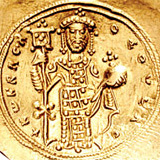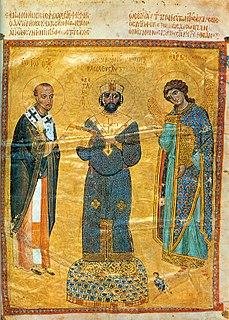 W
WAndronikos Doukas, Latinized as Andronicus Ducas, was the third son of Byzantine emperor Constantine X Doukas and younger brother of Byzantine emperor Michael VII Doukas. Unlike his other brothers, he was not named junior co-emperor by his father, and was raised to the dignity only by Romanos IV Diogenes. He is otherwise relatively insignificant, and was not involved in the affairs of state to any degree.
 W
WConstantine Doukas or Ducas, was Byzantine junior emperor from 1074 to 1078, and again from 1081 to 1087. He was born to Emperor Michael VII and Empress Maria of Alania in late 1074, and elevated to junior emperor in the same year. He was junior emperor until 1078, when Michael VII was replaced by Nikephoros III Botaneiates. Because Constantine was not made junior emperor under Nikephoros III, his betrothal to Olympias, the daughter of Robert Guiscard, was broken, which Robert Guiscard used as a pretext to invade the Byzantine Empire. John Doukas forced Nikephoros to abdicate to Alexios I Komnenos in 1081, and shortly after Alexios elevated Constantine to junior emperor under himself. Constantine remained junior emperor until 1087, when Alexios had a son, John II Komnenos. Constantine died in c. 1095.
 W
WConstantine X Doukas or Dukas, Latinised as Ducas, was Byzantine Emperor from 1059 to 1067. He was the founder and first ruling member of the short-lived Doukid dynasty. During his reign, the Normans took over much of the remaining Byzantine territories in Italy while in the Balkans the Hungarians occupied Belgrade. He also suffered defeats by the Seljuk sultan Alp Arslan.
 W
WIrene Doukaina or Ducaena was a Byzantine Empress by marriage to the Byzantine emperor Alexios I Komnenos, and the mother of the emperor John II Komnenos and of the historian Anna Komnene.
 W
WKonstantios Doukas, Latinized as Constantius Ducas, was a junior Byzantine Emperor from 1060–1078, and a senior Byzantine Emperor for a short time in 1078. Konstantios was the son of Emperor Constantine X Doukas and Empress Eudokia Makrembolitissa. Upon his birth, he was elevated to junior emperor, along with his brother Michael VII. He remained as junior emperor during the reigns of Constantine, Romanos IV Diogenes, and Michael VII, before he became senior emperor on 31 March 1078, due to the abdication of Michael VII. He was soon handed over to Nikephoros III, a usurper, due to his inability to rule. He was sent to live in a monastery, where he stayed until recalled by Alexios I Komnenos, who made him a general. He was killed on 18 October 1081, in the Battle of Dyrrhachium.
 W
WEudokia Makrembolitissa was a Byzantine Empress by marriage to Emperor Constantine X Doukas. She acted as regent of her minor sons in 1067–68, and resigned her regency by marriage to Romanos IV Diogenes. When he was deposed in 1071, she again resumed the post of regent for her sons, but was forced to resign.
 W
WMichael VII Doukas or Dukas/Ducas, nicknamed Parapinakes, was Byzantine emperor from 1071 to 1078.
 W
WNikephoros III Botaneiates, Latinized as Nicephorus III Botaniates, was Byzantine emperor from 7 January 1078 to 1 April 1081. He was born in 1002, and became a general during the reign of Byzantine Emperor Constantine IX Monomachos, serving in the Pecheneg revolt of 1048–1053. His actions in guiding his forces away from the Pechenegs following the Battle of Zygos Pass, in which they suffered eleven days of harassment before finally reaching the Byzantine city of Adrianople, attracted the attention of fellow officers, and he received the title of magistros as a reward. Nikephoros served in the revolt of Isaac I Komnenos against the Byzantine Emperor Michael VI Bringas, leading forces at the decisive Battle of Petroe. Under Emperor Constantine X Doukas he was made dux of Thessalonica, where he remained until c. 1065, when he was reassigned as dux of Antioch. While dux of Antioch, he repelled numerous incursions from the Emirate of Aleppo. When Constantine X died in 1067, his wife, Empress Eudokia Makrembolitissa, considered taking Nikephoros as husband and emperor, but instead chose Romanos IV Diogenes. The need for an immediate successor was made pressing by the constant Seljuk raids into Byzantine Anatolia, and Eudokia, Patriarch John VIII of Constantinople, and the Byzantine Senate agreed that their top priority was the defense of the empire and that they needed an emperor to lead troops to repel the Turks. Nikephoros was the favorite candidate of the senate, but was in the field leading troops in Antioch and was still married. Romanos, once chosen to be emperor, exiled Nikephoros to his holdings in the Anatolic Theme, where he remained until he was brought out of retirement by Emperor Michael VII and made kouropalates and strategos of the Anatolic Theme.
 W
WRomanos IV Diogenes, also known as Romanus IV, was a member of the Byzantine military aristocracy who, after his marriage to the widowed empress Eudokia Makrembolitissa, was crowned Byzantine Emperor and reigned from 1068 to 1071. During his reign he was determined to halt the decline of the Byzantine military and to stop Turkish incursions into the Byzantine Empire, but in 1071 he was captured and his army routed at the Battle of Manzikert. While still captive he was overthrown in a palace coup, and when released he was quickly defeated and detained by members of the Doukas family. In 1072, he was blinded and sent to a monastery, where he died of his wounds.